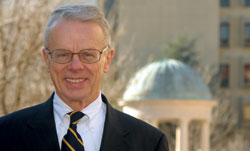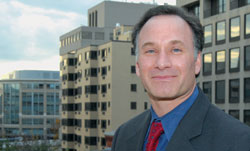|

It is our pleasure to introduce this year’s GW
Research magazine. This magazine celebrates the achievements
of our faculty members and scientists, as well as the efforts
of numerous administrative and support staff who help our
researchers carry out their important work.

|

Donald R. Lehman
Executive Vice President for Academic Affairs

Elliot Hirshman
Chief Research Officer
Jessica McConnell
|
There is much to celebrate! Our sponsored research expenditures
have reached $132 million. This record-high total caps a decade
in which such expenditures have nearly tripled. Moreover,
in the past year our researchers received prestigious Fulbright,
Coulter, and Sloan fellowships; our School of Business was
designated a Center for International Business Education and
Research by the Department of Education; and James Clark of
the Department of Biology discovered the oldest known remains
of a ceratopsian dinosaur.
This issue highlights the centrality of interdisciplinary
research to our research enterprise. The national trend toward
interdisciplinary study is driven by practical imperatives.
The problems of economic competitiveness, energy, environmental
sustainability, health promotion/disease prevention, and homeland
security challenge researchers to form interdisciplinary teams.
We are meeting this challenge and, in the process, changing
the ways in which we conduct our work.
Most importantly, synergies between the introduction of new
technology for scientific measurement and the development
of complex simulation models are speeding the pace of scientific
discovery. The work of Brian Richmond, featured in our cover
story, exemplifies this trend. Richmond uses CT imaging technology
to measure bone structures in fossils and living tissue. He
then incorporates these data into finite element simulation
models that describe the mechanical and biological functions
of the bone structures.The models provide descriptions of
the differences between fossils and living tissues, illuminating
human evolution and opening new scientific vistas.
In this context, many of the interdisciplinary faculty members
described here are national leaders in the development of
new technologies for scientific measurement. Our protein microscope
team is pioneering methods for the identification of protein
structures in extant tissue, and our cancer biosensor group
is combining microelectrical sensors with protein detection
techniques to create a biosensor that will facilitate the
early detection of breast cancer. Our researchers also are
leading the way in creating complex simulation models. Our
biological networks team is creating models of the neural
circuits that are utilized in plants under conditions of drought,
while our motion capture laboratory is devising models of
motion that facilitate the creation of biomimetic instrumentation.
Through these interdisciplinary initiatives and other efforts
described here, The George Washington University is moving
into a national leadership role in research. We hope you enjoy
this issue of our GW Research magazine and that you
will contact us to learn more about our research enterprise.
|